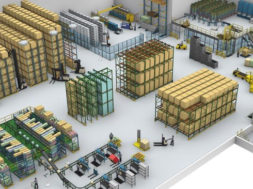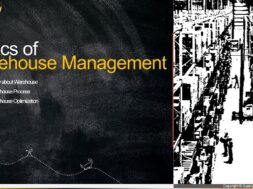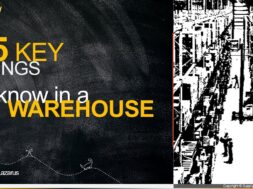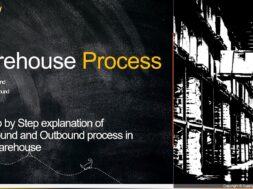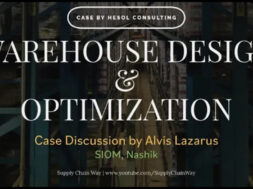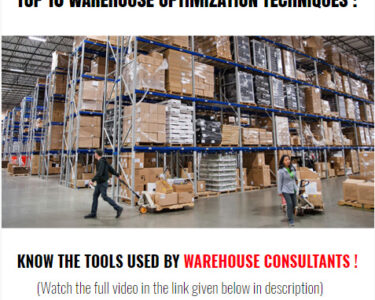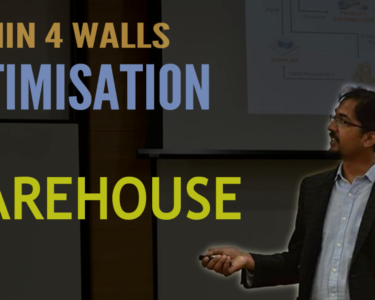
‘Warehouse Design’ & ‘Warehouse Start-Up’
Till last decade, stocking points (Warehouses) mostly called Godowns, are treated in the same manner and given the least priority in the Value Chain. The same sentiments prevailed even in the job market too; Though warehousing is an integral part of the supply chain – everyone wants to be and called as ‘SCM Manager’ rather than a ‘Warehouse Manager’. But, things have changed drastically in no time!
Warehousing has sprinted up from bottom and now plays a key role within the overall Supply Chain Strategy. There are multiple factors which contributed to the growing importance of warehousing but according to me two main factors stand out:
(1) Demanding Customers – we are in the age of world on wheels and no one likes to wait. Customers want the product the very next second, they make the purchase decision. Unfortunately, Supply Chain is not a genie and these stringent lead time expectations put in a lot of stress on the supply chain.
(2) Transportation as a Bottleneck – the stress in the supply chain puts in a direct impact on the expectations on the transportation. With more than 90% of the industry still Unorganized, Transportation in India couldn’t just cope up with the expectations and clearly a bottleneck.
These factors clearly delegate the pressure onto the strategic call of ‘Product Stocking to deliver as per Customer Expectations’.
Warehouse Start Up typically has four key steps:
Step 1: Value Stream Map – for your good sake, don’t run behind software for this and lose your money. VSM is a powerful tool when done well and it can be done well only by being on field!
I have been using VSM for past 15+ Years and it is called a pencil paper tool; we have to sweat it out on field to complete a powerful VSM. No technology can do this! Tech can give you a nice looking VSM but it can never match on content which is hand written with lot of scratches, erase marks, call outs etc.
I always tell this ‘Never do a Value Stream Map sitting on an office’
Step 2: Analysis – Value stream map generates hundreds of data points and thousands of raw data. Process it to digest the facts, trends and insights. Warehouse Design is a costly affair; you can’t just walk away with a bad implementation stating ‘I have learnt from my failure’. Use simulation tools like concepting, slotting, flow diagrams, scm simulator, logistics modelling, inventory modellers, forecasting models, etc…
Be wise here; each simulation costs in excess of 1000 USD per run. Unless you are clear on what you want, you will lose and someone will walk away with a good deal of money.
Step 3: Design – warehouse design takes care of all within the four walls – process, storage systems (racks, bins, floor, cantilevers, and automation), safety, material handling, etc. One of the most exciting areas in the entire warehouse start up. You can leverage all the simulation tools here also to ensure you are right the first time and no rework.
Step 4: Implementation – realize what you have designed. At each stage of implementation, identify all risks and have a mitigation plan before you even start implementing.
Warehouse Design and Start up is a Science. Following statistics can tell you why Warehouse Start Up is so crucial:
At India, more than 75% of Warehouses run at a capacity of less than 40%; what this means is, you are paying at-least 40% of your cost for free to the landlord plus underutilized assets.
Warehouses running at 1% of operating cost to sale Vs warehouses running at 10+% operating cost to sale, has a Himalayan impact on customer service levels and on the pricing strategy of the products handled.
Don’t think that MNC Warehouse operations are the benchmarks; most of the worst warehouses I have seen and improved, were MNC’s warehouses and some of the best warehouses I have seen are run by SMEs. Then who makes that difference? The Warehousing Head of the Business who can influence the entire organization on the importance of efficient warehouses.
Crucial Steps shared from my Warehouse Design Experience:
Following are the crucial steps part of the Warehouse start up:
Product Supply Chain & Volumes
- Understand the total number of SKUs and understand the end to end supply chain. Map a high level VSM to document all the touch points, stocking points, source and the customers.
- Forecast the volumes for next 5 years and estimate the piece volumes
- Submit the VSM & the product volumes report
Space Planning
- Document all the specific attributes of the parts and the commodity
- Calculate the recommended storage quantity for all the different product groups
- Estimate the space needed
Warehouse Layout Design & Infrastructure
- Based on volumes and the building layout, plan the different zones of the warehouse and map the same
- Allocate space accordingly for all the zones
- Freeze the end to end design of the warehouse layout
- Plan for the entire required warehouse Infrastructure
Warehouse Material Flow Design
- Mark all the entry and exit points of the warehouse
- Analyse the movement of parts, schedule of ops, cut offs, demand timings and design the parts movement
- Submit the final layout and material flow
Rack Design & Installation
- Float RFQ, do a technical evaluation and finalize the Supplier
- Coordinate with the supplier to procure the racks for the warehouse
- Estimate the type of section profiles, number of sections and location needed
- Procure and Install racks as per design
Material Handling
- Decide on the type of equipment needed
- Finalize the material handling for all parts
Parts Concepting and Transfer
- Map parts profile and characteristics
- Categorize the parts and also the locations into common codes
- Concept and transfer all parts into locations
Resource Estimation
- Arrive at the volumes and the productivity numbers
- Estimate the resources and management staff needed
WMS Set Up
- Gather requirements
- Customized and build FRD
- Build the WMS manual for client
- Demo and install the application
Warehouse Processes
- Process Design for the warehouse
- Set up the Inbound, Outbound, IM Processes, Claims process, MIS etc
- Submit all process documentation on FDM / SIPOC / Process Map
Safety Products
- Hazardous parts management
- Aisle Guards, Pallet stoppers, Safety nets, Column guards, fire extinguishers etc as needed
Warehouse Budget (OPEX)
- Fixed and Variable costing
- Release an ROM Warehouse OPEX

